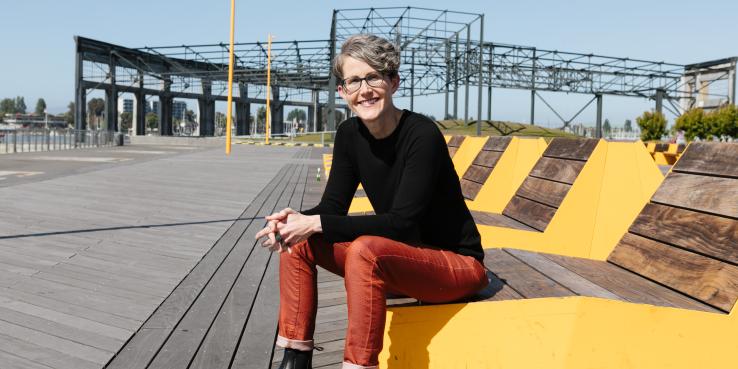This year, SPUR is celebrating staff members — a.k.a. “Spurritos”— who have served the organization for 10 years or more. This month we profile Communications Director Karen Steen, who oversees SPUR’s communications, messaging and publications while also maintaining SPUR’s brand across the region. Karen is responsible for ensuring the high quality of SPUR’s publications. Her integrity, smarts and commitment to making public policy understandable to everyone make her an essential member of Team SPUR. If you have read a SPUR report and thought, “Wow, this complex topic really makes sense to me!” chances are you are benefitting from Karen’s impressive handiwork.
Name: Karen Steen
Title: Communications Director
Start Date: March 2011
Reports published: 64
Voter guides edited: 15 guides, 157 ballot recommendations
Email newsletters sent: 520
Annual reports produced: 11
What drew you to the field of urban policy and working at SPUR?
I grew up in a classic cul-de-sac suburb where the only amenity in walking distance was my elementary school. As a kid, living in a car-dependent environment left me with little agency over my life. When I got older and traveled to urban places, I realized that life works better when the spaces around us are designed to meet our daily needs — and to support less tangible human necessities like inclusion, access and community. Working at SPUR, I get to help communicate these ideas and hopefully improve the experience of daily life for future generations.
How has working at SPUR changed the way you see urban issues?
Before I worked at SPUR, I didn’t realize how interdependent the nine counties of the Bay Area are. If one city decides it doesn’t want to allow more housing, that contributes to driving up housing costs in the surrounding cities, which in turn contributes to homelessness across the region. If one neighborhood doesn’t want bus rapid transit, that prevents the neighborhoods around it from having fast transit, which limits people’s access to jobs and opportunity. I think I’ve evolved from being an urbanist who wants to live in a place I love to being a regionalist who wants everyone to live in a place that’s worthy of their love.
What do you do when you’re not editing and producing SPUR publications?
I play surdo (bass drum) with Batalá San Francisco, an all-drum Brazilian samba reggae band. My favorite gigs are street festivals, marches and parades, where we collaborate with the audience to create a civic space that welcomes and includes everyone. Kick-starting a dance party in the middle of the street is my favorite way to “activate public space,” as the planners say.
What’s one of your favorite spots or activities in the Bay Area?
My sweetie is a planner with the East Bay Regional Park District, and we do a lot of field trips to the parks with our dog. Some of my favorite hikes follow the San Pablo Ridge. From up there, you can see all of the region’s systems at work: The bridges and BART tracks connecting downtowns and suburbs, the watersheds draining into reservoirs, the geologic system of hills and valleys, and the Bay itself, with its ecosystem of wetlands and tidal marshes. I’m grateful to all of the planners past who built the human systems, to the advocates who preserved the natural ones — and especially to the folks who saw the bigger picture and worked on both.
If you could wave a magic urbanist wand and make one proposal come true tomorrow, what would it be?
Like a lot of people who live in the Bay Area and have family or business in Southern California, I’ve spent way too many hours of my life driving I-5. I dream about the day when I can travel to see my family entirely by public transit. I live a short walk from BART, and my hometown now has an LA Metro light-rail station. I cannot wait for high-speed rail to connect the two systems, so that those of us who make this trek regularly can reclaim our lost hours with a shorter, greener, safer and more enjoyable trip.
